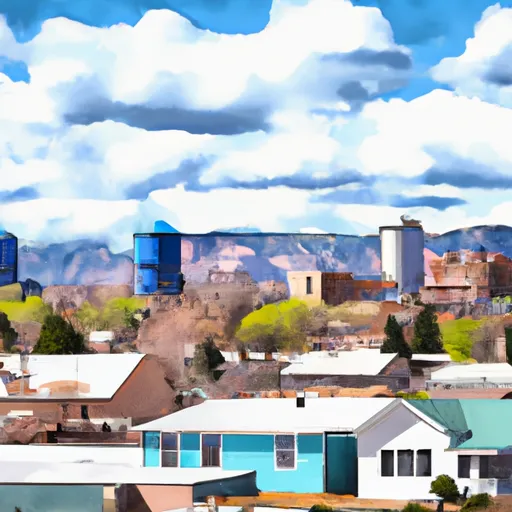-
 Snoflo Premium
Snoflo Premium
Get unlimited access to all our content
With no Ad interruptions! - Start Your Free Trial Login with existing account
Vernon
Eden Index
Climate
9.1
•
Recreation
0.7
•
Community
•
Safeguard
3.9/10

Vernon, Colorado is a small rural town located in the eastern plains of the state. The climate in Vernon is characterized by hot summers and cold winters. Summers are typically dry with temperatures reaching the high 80s to low 90s Fahrenheit, while winters bring cold temperatures with occasional snowfall and temperatures dropping to the 20s.
The hydrology in Vernon is mainly influenced by the South Platte River, which runs nearby. This river serves as a vital water source for the town and provides opportunities for fishing and boating. Additionally, there are several small lakes and ponds in the area that offer recreational activities such as swimming and picnicking.
Outdoor recreation opportunities in Vernon are abundant. The surrounding plains and nearby Pawnee National Grassland provide opportunities for hiking, camping, and wildlife viewing. Birdwatching enthusiasts can spot various species of birds, including waterfowl, in the wetlands and prairies surrounding the town. The South Platte River also offers opportunities for kayaking, canoeing, and rafting. With its diverse outdoor offerings, Vernon is an ideal destination for nature enthusiasts and those seeking to experience the beauty of Colorado's eastern plains.
What is the Eden Index?
The Snoflo Eden Index serves as a comprehensive rating system for regions, evaluating their desirability through a holistic assessment of climate health, outdoor recreation opportunities, and natural disaster risk, acknowledging the profound impact of these factors on livability and well-being.
Climate Health Indicator (CHI): 9.1
Vernon receives approximately
460mm of rain per year,
with humidity levels near 58%
and air temperatures averaging around
11°C.
Vernon has a plant hardyness factor of
5, meaning
plants and agriculture in this region thrive during a short period during spring and early summer. Most
plants will die off during the colder winter months.
By considering the ideal temperature range, reliable water supplies, clean air, and stable seasonal rain or snowpacks, the Climate Health Indicator (CHI) underscores the significance of a healthy climate as the foundation for quality living.
A healthy climate is paramount for ensuring a high quality of life and livability in a region, fostering both physical well-being and environmental harmony. This can be characterized by ideal temperatures, reliable access to water supplies, clean air, and consistent seasonal rain or snowpacks.
Weather Forecast
Streamflow Conditions
Republican
Area Rivers
Republican
Snowpack Depths
Republican
Reservoir Storage Capacity
Republican
Groundwater Levels
Recreational Opportunity Index (ROI): 0.7
The Recreational Opportunity Index (ROI) recognizes the value of outdoor recreational options, such as parks, hiking trails, camping sites, and fishing spots, while acknowledging that climate plays a pivotal role in ensuring the comfort and consistency of these experiences.
Access to outdoor recreational opportunities, encompassing activities such as parks, hiking, camping, and fishing, is crucial for overall well-being, and the climate plays a pivotal role in enabling and enhancing these experiences, ensuring that individuals can engage in nature-based activities comfortably and consistently.
Camping Areas
| Campground | Campsites | Reservations | Toilets | Showers | Elevation |
|---|---|---|---|---|---|
| Wagon Wheel - Bonny Lake State Park | 87 | 3,691 ft | |||
| East Beach - Bonny Lake State Park | None | 3,705 ft | |||
| North Cove - Bonny Lake State Park | 21 | 3,704 ft | |||
| Foster Grove - Bonny Lake State Park | 49 | 3,677 ft |
Nearby Fishing
Catastrophe Safeguard Index (CSI):
The Catastrophe Safeguard Index (CSI) recognizes that natural disaster risk, encompassing floods, fires, hurricanes, and tornadoes, can drastically affect safety and the overall appeal of an area.
The level of natural disaster risk in a region significantly affects safety and the overall livability, with climate change amplifying these risks by potentially increasing the frequency and intensity of events like floods, fires, hurricanes, and tornadoes, thereby posing substantial challenges to community resilience and well-being.
Community Resilience Indicator (CRI):
The Community Resilience Indicator (CRI) recognizes that education, healthcare, and socioeconomics are crucial to the well-being of a region. The CRI acknowledges the profound impact of these elements on residents' overall quality of life. By evaluating educational resources, healthcare accessibility, and economic inclusivity, the index captures the essential aspects that contribute to a thriving community, fostering resident satisfaction, equity, and social cohesion.

